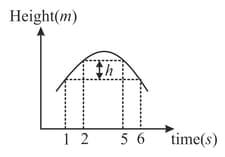HARD
NEET
IMPORTANT
Earn 100
In a straight line motion, the distance travelled is proportional to the square root of the time taken. The acceleration of the particle is proportional to:
(a)
(b)
(c)
(d)
60% studentsanswered this correctly

Important Questions on Kinematics
MEDIUM
NEET
IMPORTANT
EASY
NEET
IMPORTANT
EASY
NEET
IMPORTANT
A ball is thrown upwards. Its height varies with time as shown in the figure. If the acceleration due to gravity is , then the height is

EASY
NEET
IMPORTANT
MEDIUM
NEET
IMPORTANT
MEDIUM
NEET
IMPORTANT
Reason: A body is momentarily at rest when it reverses its direction of motion.
EASY
NEET
IMPORTANT
Reason: Speed is a scalar, but velocity is a vector quantity.
EASY
NEET
IMPORTANT
Reason: If the body is moving in the opposite direction of positive motion, then its speed is negative.
